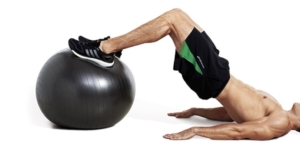
What causes weak glutes?
While there are many reasons why an individual might have weak glute muscles, one of the main causes is that many are living increasingly sedentary lifestyles. Many jobs now involve sitting down for a big part of the day, or after a long day of work go home and sit on the sofa; this means that the glute muscles can become dormant more than they should be. Another reason why someone might have weak glutes could be because of poor form and generally over-relying on other muscles during everyday movements, which contributes further to the muscles remaining inactive.
Learning to activate your glutes is important so that you can strengthen them. Strong glute muscles are extremely important as these muscles can have a major impact on your overall body strength, help to support a range of exercises and compound movements, as well as help avoid muscle imbalances which can lead to decreased mobility.
How can this be improved? I normally use these 2 exercises with clients as I feel they are the most effective and can be done anyway. If you want to make them harder , you may need some equipment such as dyna bands, barbells and dumbbells.
Glute Bridge
Lie flat on your back. Bend your knees and position your feet firmly on the floor, ensuring that they are hip-width apart and your spine is in a neutral position. Allow your arms to rest by your sides on the mat. This is your starting position.
Press your heels into the floor, activate your glutes and raise your pelvis off the floor until your body forms one straight line from chin to knee, resting on your shoulders.
Lower your pelvis to return to the starting position.
This is the most basic version of this. You can make it harder by adding extra resistance such as a dumbbell or barbell.
Donkey Kick
Start on all fours. Ensure that your knees are below your hips and your hands are below your shoulders. Set your spine in a neutral position and draw your shoulder blades down and back.
Keeping your knee bent, release and elevate your right leg until your thigh is in line with your spine, ensuring that your foot remains flexed.
Lower your right leg to return to the starting position, but without resting your knee on the floor.
Again. This can be harder by using a band or some gyms have specific machines that allow you to focus just on this movement.
